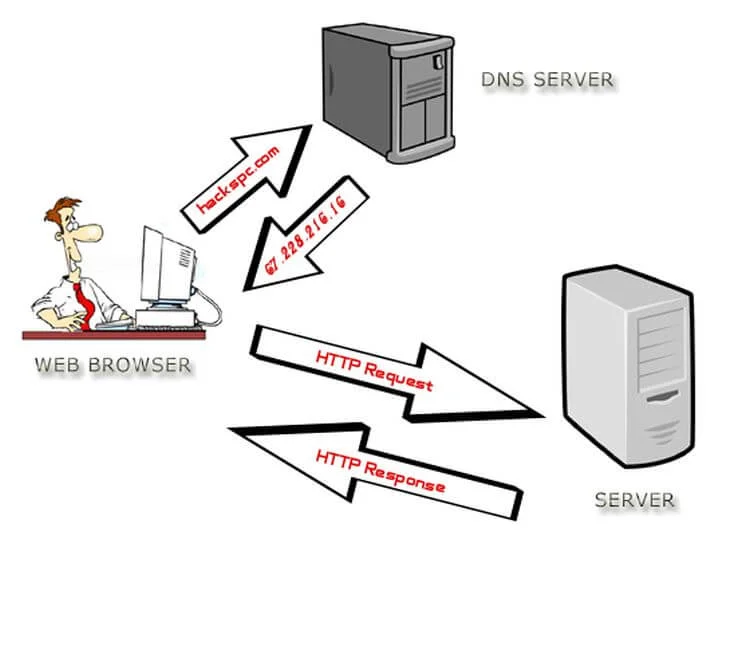How Do Web Servers Work
Last Updated: September 12, 2022

Updated February 22, 2019
Answering the question, “How do servers work?” is more than just sharing a bit of trivial pursuit info…. Servers work through a fairly simple system of request and response serving up pages of web content that you’ve requested (their work).
Without servers, the world-wide-web simply wouldn’t be able to exist. Every time you open a new web page or do some online shopping, an array of near-instant processes are taking place in a server somewhere. Servers are the powerhouses of the online experience, working to deliver all the elements, widgets and visuals we take for granted on even the simplest website. It’s also great basic information to have before you choose a hosting account for your business. Savvy shoppers know what servers need to do – and what servers to avoid.
In this piece, we’re going to break down exactly how a server works, looking at what happens when someone types in a website address onwards. We’ll also cover the different types of servers out there and which factors make for the best server hosting performance. Webserver types need not be a mystery for Scooby, Shaggy and the gang. Read on and you’ll better understand, “How do servers work?”.
What Work Does a Server Do?
At the most basic level, a server is a repository for web pages that respond when someone requests a certain website. This ‘request’ is simply the act of entering the web address into a browser and hitting return. The server monitors these requests via ports, giving their ‘response‘ nearly instantly to deliver the site page requested. Once the server has received and verified the request at-hand, it gathers the assorted elements that make up a website and communicates this assembled information back to the user’s web browser. At its core, request-response is the key to what work a server does, day in and day out.

All that remains then is for the web browser to ensure the requested site is genuine and display the page for the user. Web browsers and servers ensure the request is genuine by using TCP (Transmission Control Protocol) or IP (Internet Protocol), with HTTP overlaid to ensure seamless communication between the server and web browser in use. At the same time, web browsers use DNS (Domain Name System) to make it possible for different types of web browser to connect to a diverse range of server types and configurations by changing requests for domain names (like knownhost.com) into numeric addresses, and back again – a bit like a post office uses zip codes.
Boiled down, it works like this:
- • The web browser requests a specific web page – looking for the correct IP address associated with that domain.
- • The web browser requests a full URL for the site it wants to display – sending this information over to the server.
- • The web server finds and assembles all the information needed to display the site – including things like ads, dynamic elements, content and more. The server then sends this complete package of information back to the web browser as a response.
- • The web browser receives this complete page and displays it for the user.

The Technology of Servers Explained
Because servers can take thousands of web page requests every minute, they feature specialized technology and a unique build structure in order for each server to carry out this work. This is what enables them to manage the heavy workload they experience day after day.
The way servers use disks is very different from the average desktop computer, which generally uses a single hard drive for storage and delivery. Instead, servers use something called RAID (Redundant Array of Inexpensive Disks). What this means is that servers always have multiple hard drives working at the same time – with the same information stored across every drive. The reason servers use this configuration is to safeguard against drive failure and downtime – which is vital if you’re running, for example, a business website that you always need online. If one drive in the RAID setup fails, it doesn’t affect the overall operational capability of the server. The server can simply pull the information stored on the broken drive from one of its companions and get on with serving up the data requested. There are different levels of RAID, with KnownHost using RAID-10 in our hosting plans. We use RAID-10 because it makes for easy, downtime-less copying of information to new drives and delivers ultra-fast data transfer speeds.
In addition to RAID using traditional hard drives, KnownHost uses SSD RAID – combining the power and speed of solid state drives, with no moving parts, to give the absolute maximum performance.
Beyond this, servers must also have an ample supply of RAM and CPUs, as these elements help to manage the expected number of incoming requests and oversee ongoing server tasks, respectively.
Server Technology in a Nutshell:
- • RAID (Redundant Array of Inexpensive Disks) storage. Multiple versions of the dame data are stored on different drives, so it’s always possible to serve incoming requests – even if one drive malfunctions.
- • RAM provides the speed needed to meet large numbers of requests.
- • The CPU is the overseeing element of the server, ensuring that all tasks are allotted to the right place and proceeding as planned.
Server Types Explained
Because there are so many different hosting needs out there, there is a huge diversity in the types of servers available and the array of work that servers carry out. This can range from servers specifically targeted to supporting online chat platforms, through to mail servers designed for managing corporate communications. We’re going to focus in on application, database and web servers, as these are three of the most common server-types available. The type of server dictates the type of work requests accepted, types of data stored and how they fit into the overall content delivery architecture.
Application servers, as the name might suggest, provide an operational setting for applications. The type of work these servers carry out is to deliver up the user’s applications – running them directly from the server. Application servers also often interface with database servers, managing the flow of data back and forth so they can deliver all necessary elements to the user.
Database servers – sometimes known as the ‘Back-End’ – undertake non-user tasks like data storage, archiving and more. Fundamentally, database servers are the bedrock of a server environment, holding and delivering all the essential information that other servers and services need to function properly. Simply put, when a client machine – which could be another server or a computer – the database server searches through all the information it holds and then passes the results back.
Perhaps the simplest server type to explain, web servers deliver content to the user via HTTP. The web server responds to an incoming request for a specific web page, then pulls all the information needed to present that page together. Then it returns all that information in a complete form, displaying the requested web page in the user’s browser.
Server Types Simplified:
- • Application Servers – Provide a running environment for applications, delivering up functional applications as requested.
- • Database Servers – Handle data storage and retrieval, feeding the requested data back to other servers that require the information they hold.
- • Web Servers – Deliver requested content to web browsers, pulling all the disparate information together that makes up a webpage. Using HTTP, it communicates this requested information back to the web browser, displaying a full web page for the user.

What Makes for Good Hosting?
While this is a partially subjective question, there are underlying qualities that mark out superior quality hosting.
Customer support and price are two of the most important factors to consider because you need to know that you’re going to get the help you need if you have an issue with your hosting. Price is also a key point to consider, as this determines if you’re truly getting value for money from the hosting plan you choose. Some hosting deals can seem ideal, but they fall down when you realize many services – like migration, DNS configuration, setup and more – aren’t included in the price of your plan. These are included at no added charge with KnownHost.
It’s also vitally important to ensure you do the legwork on the hosting company you’re considering because many hosting companies promise a great deal but don’t deliver. Take the time to search the web and find real, verifiable reviews – because the best insight you can get into your potential hosting provider is feedback from other customers. It’s also worth seeking out and noting the specific services on offer – from freebies included with your hosting plan, through to the security measures included with your plan.
Server management is essential if you aren’t a linux geek yourself. Managing the technical aspects of a server is best left to professionals so you have time to manage your busy life (business). This is why KnownHost plans are 100% fully managed for all accounts from shared to reseller, from VPS to dedicated.
KnownHost provides industry-leading, fully-managed hosting plans – from tailored application hosting through to our Cloud VPS hosting plans. We provide you with all the free, hands-off services you need – for things like migration and setup – with free cPanel, 24/7 USA-based support and holistic protection from security threats. Check our homepage and find the ideal, affordable hosting plan for you, or speak with a sales rep who can help find the perfect fit for you, as you benefit from our world-class service and unmatched 99.99%+ average uptime.